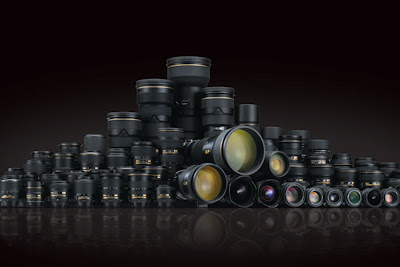 |
| Nikon Lenses |
Nomenclature means devising names of things; to know the name of a thing itself is to know something about the thing; Nikon is one of the two leading brands in cameras (the other being Canon) and here we deal with the naming of Nikon’s lenses. Brief descriptions of the functions of the parts also are given wherever necessary. It is hoped that this small article would be beneficial to beginners as well as professionals.
AF-S
Denotes that the lens is using a silent wave motor (Similar to Canon's "USM" technology) for fast and quiet autofocus, required for camera bodies not provided with focus motor.
A/M
A/M mode (autofocus with manual override, AF priority mode); it is an “autofocus-priority autofocus” mode that reduces the sensitivity of the manual override to prevent unexpected switching from auto to manual.
A – M
A-M switch - An element that locks the focus ring during autofocus while enabling behavior similar to a manual focus lens that functions in manual focus mode with sufficient load when the focusing ring is rotated.
AS
‘Aspherical’ lens elements virtually eliminate the problem of coma and other types of lens aberrations - even when used at the widest aperture. They are particularly useful in correcting the distortion in wide-angle lenses. In addition, use of aspherical lenses contributes to a lighter and smaller lens design.
CRC
‘Close Range Correction’, allows lenses to focus closer, it provides superior picture quality at close focusing distances and increases the focusing range. With CRC, the lens elements are configured in a ‘floating element’ design; wherein each lens group moves independently to achieve exact focusing. This ensures superior lens performance even when shooting at close distances.
The CRC system is used in fisheye, wide-angle, Micro, and selected medium telephoto ‘NIKKOR’ lenses.
‘D’
Distance information passed on to the camera body,‘D’ type lenses relay subject-to-camera distance information to AF Nikon camera bodies. This feature makes possible to enable advanced technologies like 3D Matrix Metering and 3D Multi-Sensor Balanced Fill-Flash.
‘DC’
AF DC-NIKKOR lenses - exclusive NIKKOR lenses for unique portraits, feature exclusive Nikon Defocus-image Control technology. This allows photographers to control the degree of spherical aberration in the foreground or background by rotating the lens' DC ring. This can give a rounded out-of-focus blur that is ideal for portrait photography. At present no other lenses in the world offer this special technique.
‘DX’
Digital, Short Back; The Nikon DX format is an alternative name used by Nikon Corporation for APS-C image sensor format being approximately 24×16 mm.
‘ED’
ED (Extra-low Dispersion) glasses enable lenses to achieve superior sharpness and color correction by minimizing chromatic aberration.
‘FX’
F X denotes (Film or digital) film for full-frame cameras.
‘G’
Lens without aperture ring; aperture is controlled from the camera body
‘IF’
Internal Focusing – enables a lens to focus without changing its size. All internal optical movement is limited to the interior of the non-extendable lens barrel. This allows for a more compact, lightweight construction as well as a closer focusing distance. In addition, a smaller and lighter focusing lens group is employed to ensure faster focusing. ‘IF’ system is featured in most of the NIKKOR telephoto and selected NIKKOR zoom- lenses.
‘M/A’
M/A mode allow switching from autofocus to manual operation with virtually no time lag - even during AF servo operation; regardless of AF mode in use.
‘ML’
Meniscus Protective Lens - A curved meniscus protective glass element is installed in front of the lens to minimize ghosting by diffusing light re-reflected from the image sensor or film and the protective glass. Its use ensures a clear image with little ghosting.
‘N’
The letter ‘N’ stands for ‘Nano crystal coat’: Greatly reduces flare due to internal reflections of light.
‘RD’
Rounded Diaphragm, point light sources create regular polygonal shapes by ordinary diaphragm blades whereas inrounded diaphragm; blades designed to create a circular opening for a more beautiful soft-focus effect.
‘RF’
Rear Focusing (RF) system, all the lens elements are divided into specific lens groups, with only the rear lens group moving for focusing. This makes autofocusing operation smoother and faster.
‘SIC’
Super Integrated Coating is an exclusive multilayer lens coating that helps reduce ghost and flare to a negligible level. It also achieves a number of objectives, including minimized reflection in the wider wavelength range and superior color balance and reproduction. Nikon Super Integrated Coating is especially effective for lenses with a large number of elements, like our Zoom-NIKKOR lenses.
‘SWM’
Silent Wave Motor converts “traveling waves” into rotational energy to focus the optics. This enables high-speed autofocusing that's extremely accurate and super quiet.
‘VR’
Vibration Reduction minimizes image blur caused by camera shake, and offers the equivalent of shooting at a shutter speed up to 4.5 stops* faster. It allows handheld shooting at dusk, at night, and even in poorly lit interiors. The lens' VR system also detects automatically when the photographer pans — no special mode is required.
Most of these features are denoted very brief names; by either single, two or three letters; one who is not familiar with these short-forms may get puzzled at times. Hence it is recommended for beginners for repeated reading and for professionals for occasional reference; however tasty a dish be; if the chef doesn’t no its name; what to say!
Post a Comment